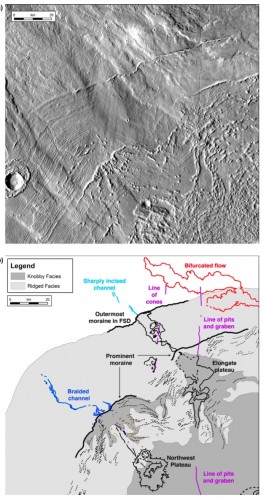Arsia Mons is one of the giant volcanos of Tharsis — Mars’ third tallest, in fact. During past cycles of climate change, it accumulated a large fan-shaped deposit of glacial ice on its northwest flank. (The other tall Tharsis volcanos also show evidence of similar glacial deposits on their northwestern sides.)

POSSIBLY HABITABLE. Landforms in glacier-related deposits on the northwest side of Arsia Mons suggest volcanic eruptions under the ice created lakes of meltwater that might have been habitable as recently as 210 million years ago. (Image taken from Figure 4 in the paper.)
New work by Kathleen Scanlon (Brown University) and co-authors from Brown, Lancaster University, and Boston University suggests that about 210 million years ago, volcanic eruptions under the ice on Arsia Mons created lakes within the glacial ice. The liquid water left geological traces on the volcano and its flank, and in addition, the lake waters could have provided habitable environments for any extant Martian life. The team’s work is published in Icarus.
The ice-covered lakes of Arsia Mons would have held hundreds of cubic kilometers of meltwater, say the scientists. As lead author Scanlon notes, “This is interesting because it’s a way to get a lot of liquid water very recently on Mars.”
Subglacial eruptions occur on Earth today primarily in Iceland and Antarctica. Depending on the relative amounts of ice and lava, how long the eruptions last, how permeable the glacial ice is, and the eruption’s location within the glacier, the meltwater may be contained wholly within the glacier or it may escape. On Mars, say the researchers, the meltwater’s effects can be found on the ground that lay under the glacial ice.
Using images from the HIRISE camera on NASA’s Mars Reconnaissance Orbiter, Scanlon found pillow-lava formations, similar to those that form on Earth when lava erupts at the bottom of an ocean. She also found ridges and mounds that form on Earth when glacial ice constrains a lava flow and glacial meltwater chills the erupting lava into fragments of volcanic glass. These form mounds and ridges with steep sides and flat tops. The analysis also turned up evidence of a river formed in a jökulhlaup, a massive flood that occurs when water trapped in a glacier breaks free.
From the sizes of the formations, Scanlon estimates that, “Together, these eruptions involved hundreds of cubic kilometers of subglacially erupted lava.”
Scanlon found that two of the deposits would have created lakes containing around 40 cubic kilometers of water each. That’s almost a third of the volume of Lake Tahoe in each. Another of the formations would have created around 20 cubic kilometers of water.
Even under frigid Martian conditions, that much ice-covered water would have remained liquid for a substantial period. Scanlon’s rough calculations suggest the lakes could have persisted or hundreds or even a few thousand years. That may have been long enough for the lakes to be colonized by microbial life forms, if in fact such creatures ever inhabited Mars.
“Glacio-volcanic environments are important microbial habitats on Earth,” the team says. “And the evidence for widespread liquid water in the Amazonian-aged Arsia Mons fan-shaped deposits makes it one of the most recent potentially habitable environments on Mars.”
Such environments, they add, “could have provided refugia for any life that developed on Mars and survived on its surface until the Amazonian.”








